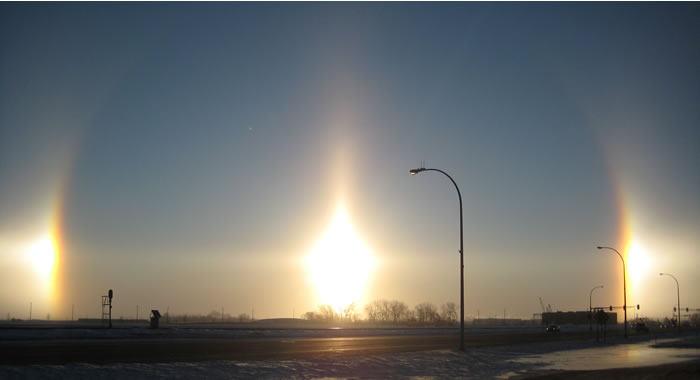
The other day I discovered the wonderful word sun dog, which refers to coloured patches of light that appear beside the sun at certain times, particularly when the sun is low in the sky. The scientific name for this phenomenon is a parhelion, from the παρήλιον (parēlion – beside the sun); from παρά (para – beside), and ἥλιος (helios – sun) [source].
In French sun dogs are known as parhélie, faux soleil (“fake sun”), soleil double (“double sun”), œil de bouc (“billygoat’s eye) or chien du soleil (“sun dog). In other languages their names are mainly based on the Greek, or some variation on fake sun.
There are also such things as moon dogs, mock moons or paraselenes, which are patches of light that appear beside the moon, though they are rarer than sun dogs, difficult to see, and only appear when the moon is very bright and full or nearly full. [source].
The friend who told me about sun dogs was using it to describe a halo around the moon or lunar halo, which, like sun and moon dogs, is a result of the refraction of light through ice crystal in cirrostratus clouds high in the upper troposphere [source]. On the night when we were talking about sun dogs the moon was only half full, so I don’t think there were any moon dogs about, but there definitely was a halo around the moon.
“There is also such things as …” Does this usage represent a dialect form???
No, that’s just a typo – now corrected. I have noticed that a lot of people use is where are is more appropriate though, and I do that sometimes.
The Wikipedia article is somewhat misleading, in that it may give the impression that “sundog” refers to ice crystal halos in general, but the term specifically means either of those bright spots to the left and right – so there are actually two sundogs in this picture. The most probable explanation for the name I’ve heard is that the spots are the sun’s “companions”; hence, dogs. In Dutch we call them bijzonnen; German says Nebensonnen, both of which mean something like “co-suns”.
The picture shows other halo types as well: the 22° circular halo, a sun pillar and the parhelic circle. For those interested in learning more about these phenomena, check out Atmospheric Optics.
In Russian, if you catch the Sun in a small mirror and reflect its light to a wall, this patch of light is called солнечный зайчик (sun bunny).
In Finnish, sun dogs are called sivuaurinko ‘side sun’.
In Japanese, they are 幻日 genjitsu ‘phantom sun’ or ‘illusion sun’. Likewise, moon dog is 幻月 gengetsu ‘phantom moon’.